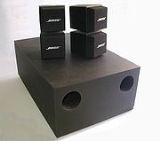
Bose stereo speakers
Encyclopedia

Overview
During the company's first year in business the Bose Corporation engaged in sponsored research. Its first loudspeaker product, the model 2201, dispersed 22 small mid-range speakers over an eighth of a sphere. It was designed to fit in the corner of a room, reflecting the speaker's sound as a mirror would for light in a corner cube and giving rise to an acoustical image of a sphere in a vastly larger room. Amar Bose used an electronic equalizerEqualization
Equalization, is the process of adjusting the balance between frequency components within an electronic signal. The most well known use of equalization is in sound recording and reproduction but there are many other applications in electronics and telecommunications. The circuit or equipment used...
to adjust the acoustical output for flat total radiated power.
Although these speaker systems accurately emulated the characteristics of an ideal spherical membrane, the results of listening tests were disappointing (some of the reasons for this are detailed in a later publication from Bose's research department). This led Bose to conduct further research into psychoacoustics that eventually clarified the importance of a dominance of reflected sound arriving at the head of the listener, a listening condition that is characteristic of live performances. This finding led to a revised speaker design in which eight of nine identical small mid-range drivers (with electronic equalization) were aimed at the wall behind the speaker while one driver was aimed forward, thus ensuring a dominance of reflected over direct sound in home listening spaces, replicating the dominant reflected sound fields listeners experience in live performances.
Before hearing his new design for the first time, although confident that his new design would produce a more faithful replication of the "live" listening experience, Amar Bose was unsure as to whether his new "direct/reflected" design would be a small audible improvement or a large one over his earlier design and the best commercially available loudspeakers. The new pentagonal design, named the Model 901, was a very unconventional design for speakers at the time (which were generally either full-size floorstanding units or bookshelf type speakers). The Model 901 premiered in 1968 and was an immediate commercial success, and the Bose Corporation grew rapidly during the 1970s.
Amar Bose believes that imperfect knowledge of psychoacoustics limits the ability to adequately characterize quantitatively any two arbitrary sounds that are perceived differently, and to adequately characterize and quantify all aspects of perceived quality. He believes, for example, that distortion is much over-rated as a factor in perceived quality in the complex sounds that comprise music, noting that a sine wave
Sine wave
The sine wave or sinusoid is a mathematical function that describes a smooth repetitive oscillation. It occurs often in pure mathematics, as well as physics, signal processing, electrical engineering and many other fields...
and a square wave
Square wave
A square wave is a kind of non-sinusoidal waveform, most typically encountered in electronics and signal processing. An ideal square wave alternates regularly and instantaneously between two levels...
(a hugely distorted sine wave) are audibly indistinguishable above 7 kHz
Hertz
The hertz is the SI unit of frequency defined as the number of cycles per second of a periodic phenomenon. One of its most common uses is the description of the sine wave, particularly those used in radio and audio applications....
. Similarly, he does not find measurable relevance to perceived quality in other easily measured parameters of loudspeakers and electronics, and therefore does not publish those specifications for Bose products. The ultimate test, Bose insists, is the listener's perception of audible quality (or lack of it) and his or her own preferences.
This reluctance to publish information is due to Bose's rejection of these measurements in favour of "more meaningful measurement and evaluation procedures".
Bose 901 speakers
The Bose 901 Speaker System is a speaker system originally created in 1968. The speakers were a huge success for Bose making it grow rapidly throughout the 1970s. The speakers are a company hallmark for Bose.Design
When the speakers were released in 1968, they featured a pentagonal design which was very unconventional at the time (many of the speakers at the time were either full-size floorstanding units or bookshelf speakers). This design helps the speakers use "Direct/Reflecting" technology that uses the walls and ceiling around it to distribute sound throughout a room (like in a live performance). To do this the speaker has eight Full-rangeFull-range
A full-range loudspeaker drive unit is defined as a driver which reproduces as much of the audible frequency range as possible, within the limitations imposed by the physical constraints of a specific design. Frequency range is of these drives is maximized through the use of a whizzer cone and...
drivers in the back and one in the front. The "Direct/Reflecting" technology is designed to reproduce the acoustics of a live performance on stereo speakers, however, studio recordings may sound the same as they do on conventional speakers.
Specifications/Features
- Nine Full-Range Drivers – One direct firing speaker and eight rear firing speakers.
- Active Equalizer – The speaker set includes an equalizer made specifically for the speakers. This controls frequency outputs to the speakers.
- A special Acoustic Matrix Enclosure – This helps reduce speaker chamber noise and to help hear well-defined low frequencies over the low-frequency spectrum.
- Helically-Wound Aluminum Voice Coils – These are designed for high durability, greater efficiency and superior power handling.

